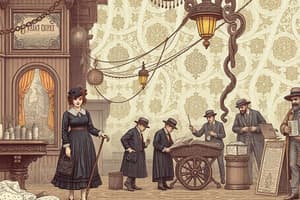Podcast
Questions and Answers
Which of the following best describes the focus of employee relations?
Which of the following best describes the focus of employee relations?
- Focusing on industrial production and manufacturing processes
- Negotiating trade agreements with international partners
- Balancing the needs and interests of both employers and employees (correct)
- Managing workplace safety and preventing accidents
Industrial relations and employee relations have the same focus.
Industrial relations and employee relations have the same focus.
False (B)
Name two parties typically involved in employee relations.
Name two parties typically involved in employee relations.
Employer, Employee, Trade Unions
A collective agreement between employees and employers is an example of an employee relation ______.
A collective agreement between employees and employers is an example of an employee relation ______.
Match the following mechanisms used to manage employee relations with their descriptions:
Match the following mechanisms used to manage employee relations with their descriptions:
Which of the following is an example of an external factor influencing employee relations?
Which of the following is an example of an external factor influencing employee relations?
According to the unitarism perspective, workplaces are generally a site of class struggle between employers and employees.
According to the unitarism perspective, workplaces are generally a site of class struggle between employers and employees.
Based on Scientific Management theory, what is the primary motivator for employees?
Based on Scientific Management theory, what is the primary motivator for employees?
The Human Relations theory suggests that productivity can be increased by meeting workers' ______ and ______ needs.
The Human Relations theory suggests that productivity can be increased by meeting workers' ______ and ______ needs.
Which action exemplifies labor and management working together to meet the changing business interest?
Which action exemplifies labor and management working together to meet the changing business interest?
Flashcards
Employee Relations
Employee Relations
Relationship between employers and employees, managed via policies and agreements.
Industrial Relations
Industrial Relations
All work-related activities (contracts, policies, HR, conflict resolution).
Aims of Employee Relations
Aims of Employee Relations
Fair treatment, work-life balance, and employee success.
Employee Relation Parties
Employee Relation Parties
Signup and view all the flashcards
Employee Relation Process
Employee Relation Process
Signup and view all the flashcards
Employee Relation Outcome
Employee Relation Outcome
Signup and view all the flashcards
Role of Employees
Role of Employees
Signup and view all the flashcards
Role of Employers
Role of Employers
Signup and view all the flashcards
Role of Trade Unions
Role of Trade Unions
Signup and view all the flashcards
Role of Government Agencies
Role of Government Agencies
Signup and view all the flashcards
Study Notes
Concepts of Employee Relations
- Employee Relations' focuses on the relationship between employers and employees in a workplace
- It involves policies, rules, and agreements to manage employees
- Example: creating a policy for flexible working hours to improve satisfaction
Industrial Relations (Previous name)
- "Industrial Relations" focuses on employees
- Consists of all work-related activities like employment contracts and workplace policies
- Example: safety rules to ensure workers follow guidelines and avoid accidents
Aims of Employee Relations
- Fair treatment, payments & benefits, work-life balance, and safe working conditions
- Treat employees like stakeholders
Employee Relation Parties
- Employer, employee and Trade unions
Employee Relation Process
- Collective bargaining between unions & employers takes place
- Industrial disputes & dispute resolution mechanisms are used
- Employee participation at workplace
Employee Relation Outcome
- Collective agreement between employees & employer achieved
- Decision by a tribunal or conciliation committee that resolves a dispute
- Agreement between employees and an employer on an issue at the workplace
Industrial Disputes & Dispute Resolution Mechanisms
- The employee relations system contains four key components
Players (Parties in Employee Relations)
- Employees work under contracts with rights and responsibilities
- Employers provide jobs, set policies, and comply with labor laws
- Trade Unions represent employees in negotiations
- Government Agencies create labor laws and practices
- Example: The Ministry of Manpower in Oman ensures companies follow labor laws
Mechanisms (Ways Employee Relations Are Managed)
- Consultation where Employers discuss workplace changes with employees
- Employee Involvement & Participation through worker contribution to decision-making
- Communication Process involves open sharing of information
- Collective Bargaining between trade unions and employers
- Legal Regulation: Government sets labor laws
- Example: minimum wage laws in many countries
External Environment
- Employee relations are influenced by external factors
- Government Policies: Labor laws regulate employment
- Economic Conditions: Job availability, wages, and inflation
- Social and Cultural Factors: Employee expectations and workplace norms
- Technological Advancements: Automation and digitalization
Bargaining Power
- Bargaining power refers to the influence employees and employers have in negotiations
- Employees have strong bargaining power with rare skills or work in essential industries
- Employers have strong bargaining power when there are many job seekers and fewer jobs
- Example: Airline pilots have strong bargaining power
Significance of Employee Relations
- Helps to Establish Industrial Democracy
- Contributes to Economic Growth and Development
- Improves Employee Morale
- Ensures Optimum Use of Scarce Resources
- Reduces Unfair Practices
- Encourages Implementation of Sound Labor Laws
- Facilitates Organizational Change
- Reduces Employee Disputes
- Increases Productivity and Reduces Wastage
- Creates a Positive Work Culture
Different Views about Employee Relations
- Manager's Perspective: Focuses on maintaining a productive workforce
- Trade Unionist's Perspective: Protecting employee rights
- Individual Employee's Perspective: Improving work conditions based on their personal experiences and job expectations
- Government and Third-Party Perspective: Maintaining fairness in employee relations and compliance with labor laws
Employment Relationship
- Differences can arise within management
- Different Interests can be observed among employees themselves
- Recognize the different interests that exist
- Seek out common interests between employers and employees
Theories & Strategies of Employee Relations
- The workplace is like a family where employees and employers share common goals
- Promote teamwork to discourage trade unions
(Scientific Management theory)
- Employees work best when they follow strict rules and specific tasks like machines
- Increase efficiency and productivity
- Employees are motivated by money
- Ford's Assembly Line exemplifies simple, repetitive tasks to make car production fast and efficient
(Human Relations theory)
- Employees work best when they feel happy, valued and motivated
- Increase productivity by meeting workers social and emotional needs
- The goal is achieved when managers care about employee feelings
- Managers Encourage teamwork by making employees not just tools
- Ensure workers can make decisions and that motivation matters to them
Maslow's Hierarchy of needs :
- Physiological needs: Water, food, salary, comfortable working place
- Safety needs: Job security, safe working conditions, health insurance, retirement plans
- Social needs: Friendships, teamwork, and a sense of belonging
- Esteem needs: Promotions, awards, praise from managers, challenging tasks
- Self-Actualization: Career growth, leadership opportunities, freedom to be creative
- Example: Google provides a fun work environment, teamwork, and career growth opportunities
Pluralism
- Conflicts between employers and employees are natural, and trade unions help resolve issues
- Involves balancing employer and employee interests and value
- Example: A company negotiates salaries with a workers' union
(Systems theory)
- Employees relations follow a set of rules influenced by external factors
- Maintain fairness through rules and negotiation
Actors on Employee relations
- Employers set policies and business goals
- Employees & Trade Unions represents workers' rights
- Government & Regulatory Agencies set labor laws and resolve disputes
Enviromental contexts
- Technology causes Changes in workplace automation and tools
- Market Conditions are Economic trends affecting employment
- Budget Constraints are Financial factors influencing salaries and benefits
- Power Distribution is the influence of unions, employers, and government
Rules Covering employee relations
- Procedural Rules address how disputes and negotiations should be handled
- Substantive Rules address agreements on wages, working conditions, and employee rights
- Common beliefs and Ideologies, encouraging compromise and negotiation
- Example: UK labor laws allow trade unions to negotiate fair wages and working conditions
Marxism
- The workplace is a site of class struggle between employers and employees
- Employees protest against unfair wages
(Labor Process theory)
- Employees relation follows set of rules influenced by external factors
- Expose and fight against worker exploitation caused by capitalist systems
- Show how technology and strict management control workers
- Explain how jobs are de-skilled so workers lose independence
- Encourage trade unions, strikes, and protests to resist unfair treatment.
- Amazon warehouse workers protesting long hours, low pay, and poor working conditions.
Role of Different Parties in Employment Relations
- Different groups have specific roles that help maintain a fair and productive workplace
Role of Employees
- Employees efficiently perform assigned tasks
- Employees follow all workplace policies
- Employees participate in decision-making, giving feedback to improve work conditions
- Employees reporting unfair treatment or unsafe working conditions
Role of Employers
- Providing jobs and fair wages
- Ensuring a safe and healthy work environment
- Following labor laws
- Encouraging employee growth
Role of Government
- Making and enforcing labor laws
- Protecting employees from exploitation
- Providing dispute resolution systems
- Acting as a major employer in public sector jobs
Role of Managers
- Ensuring smooth workplace operations
- Maintaining good communication
- Promoting teamwork
- Resolving conflicts
Role of Trade Unions
- Negotiate better salaries and benefits
- Protect workers from unfair treatment
- Ensure workplace safety
- Provide legal support
Role of Employee Relations Players in a Changing Business Environment
- Adapting to globalization, technology, and economic shifts
Changing Role of Trade Unions
- Less power today due to outsourcing, short-term contracts, and government labor laws
- More companies are hiring contract workers
- Direct communication between employees and HR reduces the need for unions
- Government labor laws protect workers
Changing Management and Labor Interests
- Both employers and employees now prioritize different needs compared to the past
Companies want
- Highly skilled workers
- Soft skills
- Cost efficiency
Employees want
- Job security
- Career growth opportunities
- Fair wages and benefits
Labor and Management Working Together to Meet Changing Interests
- New HR policies need to be friendly to employees
- Employees need flexible working arrangements
- Employees should have skills development programs
Studying That Suits You
Use AI to generate personalized quizzes and flashcards to suit your learning preferences.




